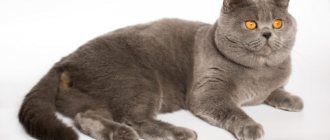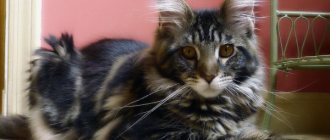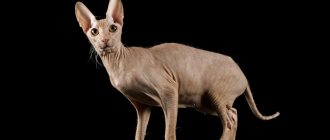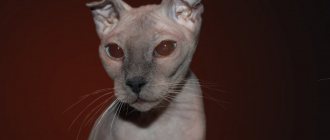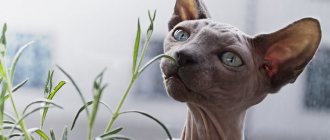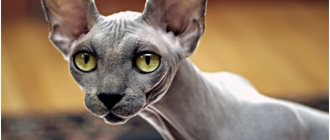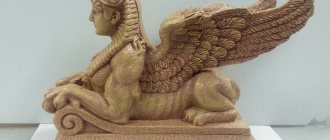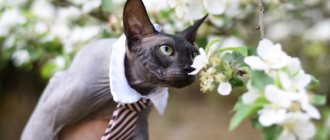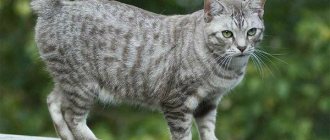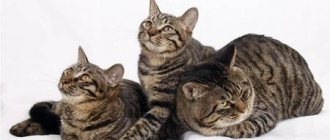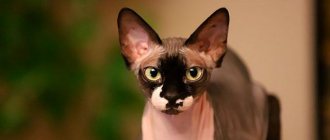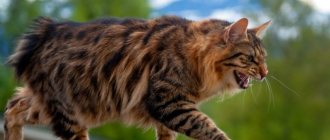Description and history of the Canadian Sphynx
The history of the breed goes back more than 50 years, since 1966. However, there is evidence that such cats were already encountered in ancient times. They began to be specially bred only in the mid-20th century in Canada. Today, the Canadian Sphynx is a breed recognized by all felinological organizations.
These cats have a gene responsible for the lack of hair. It is transmitted in a recessive manner. The reason for the appearance of this gene mutation is unclear. But at one time, experts began to breed a breed of hairless cats, crossing hairless animals with short-haired ones, maintaining and preserving the trait.
The body of the Canadian Sphynx is graceful, with well-developed, proportional legs. The head is small, round in shape. No mustache. The eyes are large, round, and the color of the iris is most often yellow. The ears are large and very wide at the base. Despite the fact that Sphynxes are called bald or hairless, Canadians always have a barely noticeable fluff on their body.
Difference in origin
The Canadian Sphynx was bred approximately 50 years ago and immediately won the hearts of feline fans. This breed is not related to the Egyptian pyramids.
The history of the Sphynx began in the province of Ontario (1966), when an ordinary couple gave birth to a hairless kitten. Later, breeders from the USA joined the selection, and as a result of inbreeding, they managed to consolidate the differences in the breed characteristics of the new species.
Later (2006), Canadian Sphynxes, together with American Curls, were used to create the elf breed. These were completely “naked” cats with the shape of the ear, characteristic of the fairy-tale characters of the same name. The selection was successful, but has not yet received official development.
Color and tabby
The breed standards that apply to color are presented for the Sphynx as solid, tabby, and tortoiseshell.
Solid colors
- The Black Sphynx has a graphite body coat with a gray tint and a black nose, and the paw pads can be either black or dark brown.
- Blue color is a bleached black, light blue skin tone has a silver tint, the nose and pads are gray.
- The Chocolate Sphynx is a color that runs the gamut from bitter dark chocolate to milk cocoa, with a nose that matches the skin tone and paw pads that range from pink to light brown.
- The lilac color of the Sphynx has a silver tint with a pink tint, and the nose and paw pads are lavender.
- Red color is typical for kittens, since with age the existing stripes and bright spots disappear, and only the paw pads and nose are brick or pink in color.
- The cream Sphynx has a color derived from red and comes in shades of pink to almost white with a pink nose and pads. The offspring of a cream female and a female cat are tortoiseshell in color.
- Cinnamon or cinnamon color completely colors the Sphynx's skin, right down to the pads and nose.
- The faun is represented by a uniform light beige color for all parts of the animal's body.
- The white color ranges from white to pink with pink paw pads. For shades of this color, the color of the eyes is decisive: blue eyes - white, intense blue - pale pink, orange eyes - white.
Tortoiseshell colors
- The black turtle is represented by a black body cover, on which there are red or cream areas, and on the face - a red spot.
- Blue turtle - blue skin has cream spots on the body and always on the pet's face.
- The purple tortoiseshell is lavender in color with creamy areas and a cream patch on the face.
- The chocolate turtle comes in a reddish color closer to brown and has a red marking on its face.
- Tortoiseshell cinnamon has a gray-brown body color with creamy areas and a red spot on the face.
- Tortoiseshell faun has ivory skin with cream spots and the same marking on the face.
Sphynx tabby
- The marbled color is clearly expressed on the cat's limbs and tail. On the paws it is in the form of brackets, and the tail is covered with uniform rings. The color also appears as a necklace on the neck and chest. On the muzzle, the marbled color looks like the letter W and a rounded pattern on the cheeks.
- The brindle is also pronounced on the tail and legs. Braces on the paws, rings on the tail and frequent rings on the neck are signs of the brindle color. This color is excluded from hairless representatives of the breed.
- The spotted color is presented in the form of round or oval spots on the body of the animal, which do not merge into a pattern. A stripe of spots runs along the spine to the very tip of the tail, and on the stomach the spots resemble buttons from clothes. Spotted color can also appear on a bald body.
- The tortoiseshell tabby combines spots of all solid colors, with a red spot on the animal's face being desirable.
- The silver tabby has a base skin color with black markings on the body, a red-brown nose, and black paws.
- The black tabby has black markings on a copper-red or brown skin background, with a red-brown nose and black paws.
- The blue tabby includes ivory skin with richer blue markings, a dark pink nose, and pink paws.
- The red tabby speaks for itself: the red skin has more contrasting red markings, the limbs are red-brown.
- The Cream Tabby has pale cream skin with deeper contrasting color markings, the nose and pads are pink.
- A chocolate tabby with beige skin and deep red-brown markings, includes a pink nose with chestnut edging and brown pads.
- The lilac tabby has lavender-colored skin, more contrasting markings, and paw pads and nose that match the overall color.
The degree of color of the Canadian Sphynx and, accordingly, the breed standard is very positively influenced by sunbathing, and the color becomes more saturated. However, abuse of sunbathing should be avoided, since the Sphynx's skin is very delicate and does not have protection from ultraviolet rays in the form of fur.
Video on the topic
Do you love cats, but can’t afford to have a pet at home because someone in your household has allergies? Or are you an extraordinary person and everything that surrounds you is also extraordinary?
Sphynx cats are what you need! But choosing a hairless pet breed must be approached with all seriousness and responsibility: you are choosing a family member. We offer you for your consideration a list of characteristics that distinguish the Don and Canadian Sphynx breeds.
Sphynx diseases
Due to their unique appearance, the main problems for sphinxes arise with the skin. Due to the intense work of the sebaceous and sweat glands, representatives of this breed may experience problems. If the animal's skin is not cleaned daily and bathed regularly, then pustules begin to form and acne appears.
When such problems appear in your pet, you should take him to the veterinarian. The doctor will prescribe treatment and give recommendations for caring for problem skin.
Diseases of the Don Sphynxes are mainly associated with various negative effects and skin lesions. The animal may experience the following problems:
- colds due to hypothermia (the sphinx can get sick even from a short stay in a draft or in a cool room);
- sunburn: exposure to direct sunlight is also contraindicated for sphinxes, as is cold (there are special creams to protect against the harmful effects of the sun);
- inflammatory skin diseases (dermatitis) that occur due to exposure to allergens, deficiency of the iodine-containing hormone thyroxine;
- trichophytosis (dermatophytosis or ringworm) is an infectious disease caused by fungi;
- allergic reactions that appear on the skin;
- eczema is a nonspecific inflammatory skin disease, manifested by skin rashes, itching, and severe discomfort.
Canadian Sphynx
All these pathologies are also found in Canadians, since they are also hairless. Canadian Sphynx cats are susceptible to the following diseases, which can also occur in Donetsk cats:
- a shortened lower jaw is a congenital developmental anomaly that may not cause harm to the pet, but when excessively expressed it causes serious damage to the oral cavity due to malocclusion (all cats with such a defect are excluded from breeding);
- microphthalmos – underdevelopment of the eyeball, often accompanied by other disorders and lesions of the visual apparatus: keratitis, cataracts, tumors, orbital cysts;
- curvature of the caudal part of the spine is a hereditary pathology, very common in sphinxes, accompanied by underdevelopment of the lower intestines, short thoracic and lumbar spine (kittens with such an anomaly are usually not viable);
- immunopathological inflammation of blood vessels (vasculitis);
- nipple hyperplasia is a hereditary anomaly transmitted through the female line (sometimes accompanied by underdevelopment of internal organs, which makes kittens unviable);
- Entropion is a genetically determined congenital defect, manifested by the edges of the eyelids being turned inwards (this pathology must be eliminated surgically, otherwise the animal will develop a chronic inflammatory process of the eye mucosa);
- “Kitten falling asleep” is a genetic disease accompanied by underdevelopment of internal organs, making kittens unviable (usually observed in a litter born as a result of crossing two hairless Don Sphynx cats).
Canadian Sphynx
Differences between breeds
The difference between the breeds begins with their history of origin: the Don Sphynxes, which recently appeared, trace their history back to Russia, while the Canadian ones have already half a century behind them, and even came from the overseas continent.
In the former, the lack of hair dominates in the processes of crossing with breeds with smooth and short hair, and in the latter, the gene for lack of hair is recessive (suppressed).
Breeds also differ in appearance. Canadians, as already mentioned, have a light fluff on the surface of their skin. It is practically invisible to the eye, but it is there. But the Don Sphynxes have both bald and “woolly” varieties.
Almost all of them are born naked, and as they grow up, they begin to acquire distinctive species characteristics. There are three species in the breed. One has no fur at all. Cats of the velor breed are covered with short hair up to 3 cm long. But the Doncha cats of the brush type have hard, curly hair.
Don Sphynx: characteristics
The Don Sphynx is a very large and tightly built cat.
Donchak people have a fairly strong physique for sphinxes: they have developed muscles and strong bones. Adult cats have a noticeable rounded tummy. The tail is straight, not too thin, long and very flexible.
The head is wedge-shaped, but the outlines are softened, the profile is harmonious. The jaws and eyebrows are well defined. A characteristic feature is the absence of vibrissae. Some animals have them, but they are short and curled. The eyes are almond-shaped, slanted, always slightly squinted. The muzzle is decorated with large, high-set, sensitive ears.
Don Chaks have virtually no hair; a small amount may remain on the paws, tail, and ears. Kittens are born completely naked. Any colors are acceptable; two-colored individuals are very common.
Differences in appearance: a portrait of two breeds
A rounded head, a distinct border line from the cheekbones to the muzzle, a flat surface of the skull in front of the ears and a strong chin running perpendicularly from the upper lip are the features inherent in the Sphynx.
You also need to add to the portrait expressive eyes (obliquely set, wide in the middle and tapering towards the corners), a long “rat” tail, folded skin covered with delicate fluff, a flexible body, strong legs and disproportionately large erect ears.
After such a portrait, you no longer have to think about the length of the body, the area of the croup and the folds on the neck. In front of you is definitely a Canadian Sphynx.
Any colors are allowed: plain, with spots and marks. The only difference that disqualifies show animals is the zonality of hair coloring.
The Don cat has a wedge-shaped head, with a sloping forehead and clearly defined cheekbones. Longitudinal folds come from behind the ear line and diverge to the sides above the eyebrows.
The eyes are almond-shaped, obliquely set. The ears are large, with a rounded contour.
The folds are located only on the head, armpits, groin and neck. In winter, a thin fluff may appear on the body of the Don Sphynx, but by the age of 2 years an adult animal should be completely naked, without hair.
Any colors are allowed - color is not a significant distinguishing feature.
Important: Don Sphynxes are hardy and have stable immunity to diseases. Their Canadian counterparts have a low pain threshold and poorer health.
Petersburg (Peterbald) Sphynx
This breed belongs to the hairless Russian domestic cats. Sphynxes of the Peterbald breed look quite elegant, these cats are graceful and slender, have a very characteristic head shape: narrow and long, with a straight distinct profile, large and almond-shaped eyes, the ears of this breed are set apart. The best representatives of this breed look like oriental hairless cats . Petersburg (Peterbald) Sphynxes have a wonderful character, they are curious, friendly, very active and intelligent. Sphinxes love absolutely all family members and require communication from them; These cats are not independent cats. Peterbalds get along well with other cat breeds and with other pets, and are also good with children.
Sphynxes of this breed are not vindictive; all these qualities make St. Petersburg (Peterbald) excellent companions. The St. Petersburg breed (Peterbald) was acquired in 1994 in Russia, the city of St. Petersburg, as a result of an experimental mating of the World Champion, the oriental cat Radma von Jaegerhoff, with the Don Sphynx Afinogen Myth. This breed of cat was bred by well-known felinologists in Russia O. S. Mironova with the participation of Tatyana Komarova. As a result, four Petersburg Sphynx (Peterbald) kittens were obtained from the first two litters: Nezhenka from Murino, Nocturne from Murino, Mandarin from Murino and Muscat from Murino. These kittens are the first founders of the Peterbald Sphynx breed.
In 1996, the St. Petersburg Sphynx breed was recognized by the SFF-Felinological Breeding Federation, and then a standard for this breed was adopted with the assignment of PBD - an abbreviation. In 1997, this cat breed was recognized by TICA - The International Cat Association and assigned this cat breed PD - an abbreviation, and in 2003, this cat breed was recognized in the WCF - World Cat Federation with PBD - an abbreviation. Other possible abbreviations and designations for this cat breed are PSX, PD, PTB and PBD. Nowadays, this breed of cats is developing in the direction of the Siamese and extreme oriental type: a long muzzle, large and almond-shaped eyes, ears, in this breed, set apart, flat cheekbones and a graceful, elegant body on high paws. That is why all existing standards of this breed allow St. Petersburg (Peterbols) mating with Siamese and Orientals , as well as semi-long-haired variations (Javanese and Balinese) .
The Petersburg breed (Peterbol) was taken by introducing the dominant hairless gene Hrbd into the population of Siamese-Oriental cats, borrowed from the Don Sphynxes.
Hairless cats have skin that behaves like human skin: in the summer it tans under the sun's rays and sweats when it is very hot. rubber sphinxes, it is very sensitive to radiation and often dries out, it is also susceptible to mechanical damage and needs special protection (lubricating with baby oil can help). In places of contact, the skin acquires strong pigmentation, and if there is insufficient sunlight, the skin loses pigment (in winter, the sun tan disappears), and remains only in moles and migrating “winter spots.” During lactation and pregnancy, pigmentation increases.
In the absence of fur, the color appears like a tattoo directly on the cat's skin. However, the skin pigment only provides a “shadow of the color”, which makes it difficult to distinguish between clear color variations of lightened and main colors. For example, the reddish brindle color of a cat will look, on a fully undressed adult cat, the same as a cream, spotted color, that is, it will visually look uniformly pink.
Only a breeder can determine the genetic color of a young kitten in its first years of life, while it still retains its baby fur. Animals of colorpoint colors sometimes have blue eyes. And in an adult individual it shows that it belongs to animals of acromelanic color. Examination at exhibitions is carried out without taking into account the types of patterns, and only at the base they are separated by agouti or non-agouti coloring.
Sphynx kittens open their eyes very early, this directly affects the degree of hairlessness in the kitten. If brush and velor kittens' eyes begin to open from the third to the fifth day of their life, then naked-born kittens are immediately born with their eyes open. And in other representatives of cat breeds, early opening of the eyes leads to blindness and drying out of the eyeball, but in sphinxes the eyes are already normally fully developed at birth, they can blink and squint, and the lacrimal glands well moisturize the mucous membranes. As a result of the same factor, in older Sphynx cats , increased lacrimation occurs, this is especially noticeable during the feeding : not many (especially naked “rubber”) cats cry, one might say crocodile tears, at the moment when they eat.
What is the distinctive feature of the Sphinx ? This is the so-called secretion of skin lubricant (a reddish-brown, waxy sticky substance) and it accumulates around the ears and claws (which sometimes causes panic among inexperienced veterinarians). However, this is a way of additionally protecting the body from the influences of the external environment. And if a Sphynx cat (light color) looks a little grimy, there is no need to subject its skin to thorough and frequent water treatments with special shampoos, but it is recommended to wipe its body with a soft cloth soaked in special oil intended for children. But an adult cat that has retained hair in places will not have such excessive skin discharge, and the cat’s owner can limit himself to only periodic cleaning of the ears.
The hairlessness gene affects both the structure of the coat and the whiskers (cat's whiskers): in heterozygous cats, this gene is preserved and sufficiently developed from birth (this often helps to determine the carrier of the hairless genes in the first moments of life). The whiskers in homozygous cats may be greatly shortened and thinned, or absent altogether.
Different breed genetics
Getting to know the fascinating world of chromosomes, loci and genes that are responsible for the absence of hair will help you better study the differences between the Don and Canadian Sphynxes.
Canadian Sphynx
Since this cat breed was the first to appear, observations of it contain a greater amount of knowledge. The selection was carried out purposefully and took into account the rich experience accumulated by felinologists.
- Back in 1938 Frenchman Etienne Letard published a description with a list of differences between hairless kittens. True, they were not talking about Canadian (and especially Don) sphinxes, but about Siamese. The allelic gene from this work was precisely the reason for the appearance of the Canadian Sphynx.
- The "bald" mutation occurs due to the recessive hr gene. In the animal's genetic map, it is responsible for the absence of integument.
- Canadian cats cannot be crossed with other breeds. The Devon Rex took part in its breeding, and hr still carries information about the difference in their genome.
Objectively, these cats are not completely hairless. They have residual growth on their tail, paws and head.
Don Sphynx
We can say that this breed is the result of a happy coincidence. If domestic lovers did not know about the existence of the bald Canadian Sphynx, they would hardly have decided on such a dizzying genetic adventure.
Moreover, the ancestor of all domestic hairless cats, Varvara, did not impress professional felinologists.
- The cause of baldness was a spontaneous mutation caused by circumstances that were never established.
- Hair loss is caused by the presence of a dominant allele (a form of the gene responsible for the development of certain traits) Hbl. In our example we are talking about the absence of vegetation on the skin.
- The difference between the Don Sphynx and the Canadian one is that it can be of 3 types:
- completely naked (rubber);
- flock (initially the animal is covered with sparse fluff, which gradually disappears);
- brush
The latter has dense fur and curly mustaches. With age, they may disappear or remain for life, adding to the list of differences from the Canadian cat breed.
Brush cats have no show value, but when crossed they produce high-quality “rubber” offspring and are therefore interesting for breeding.
Important: the difference between the Don and the Canadian Sphynx is the reason for the loss of hair. In the Russian breed, a dominant gene is responsible for this anomaly, while in an overseas cat it is recessive (suppressed).
Definitions
The Don Sphynx is a relatively young Russian breed of hairless cats. Animals have an unusual appearance. Their muscular body is covered with soft silky skin, and large almond-shaped eyes stand out on their expressively defined muzzle. The miniature head is complemented by large protruding ears. The uniqueness of the breed lies in the fact that not all of its representatives are completely hairless. Kittens of some species have pronounced hair, which they often lose with age. The first bald baby, acting as the founder of the breed, was born in Rostov-on-Don in 1990. The breeder's long-term breeding work has borne fruit. In 1996, the breed was officially registered, which over time gained fame throughout the world.
Don Sphynx
Velor Don Sphynx
Don Sphynx brush
Don Sphynxes have a cheerful and playful disposition. These are very friendly animals that easily get along with children and various representatives of the fauna, be it a dog or a rabbit. Cats of this breed are not characterized by rancor and vindictiveness. They dote on their owner, sometimes showing excessive intrusiveness. At the same time, Don Sphynxes remain quite independent and rebellious pets, putting themselves on the same level as humans.
The Canadian Sphynx is a breed of hairless cat that originated in 1966 in North America. It happened completely by accident. An ordinary smooth-haired pet from the Canadian town of Ontario brought kittens to her owners, one of which turned out to be completely bald. The cause of hair loss remains unclear. The main version is single natural mutations, which subsequently began to be preserved and maintained through crossing with smooth-haired cats.
Canadian Sphynx
The body of the Canadian Sphynx is strong and muscular, the head is of medium size with a clearly defined muzzle and protruding ears, the eyes are large and oval. If you run your hand over the soft, smooth skin of a cat, you can feel the presence of a small fluff, almost invisible to the eye. The animal has a long hairless tail, sometimes ending in a neat “tassel”, like a lion’s. Rolled into a donut, it is almost always pressed to the body. By nature, Canadian Sphynxes are very peaceful and loyal animals. They easily get along with other pets and are also distinguished by their healing abilities. This proud cat will never ask for handouts from the owner; it is much easier for her to quietly steal a tidbit from the table.
Character traits
Sphinxes, living in the vastness of Russia, are reminiscent of playful children in their disposition. These are perky creatures who are never characterized by aggression. They love human company very much. Sometimes this takes the form of obsession. Then the pebble appears everywhere your foot steps. He starts his song, rubbing himself against your hands or face.
The pronounced curiosity and desire to always be at the epicenter of events are striking. They treat strangers with interest, but do not always allow them to approach them once they reach puberty. They are sensitive with their family members and subtly sense people’s moods.
Their Canadian counterparts behave differently:
- choose their only owner,
- feel equal to a person, not allowing themselves to beg for food,
- sometimes show impulsiveness
- a little secretive, “on their own”
- restrained in their actions,
- Only a select few allow themselves to be caressed.
To read: English black cocker spaniel care and maintenance rules
At the same time, they are all very peaceful. They are endlessly devoted to those who care about them.
Features of feeding
Don Sphynx cats have a good appetite. Compared to furry cats, they spend much more energy on heating.
In this regard, sphinxes are partial to food. They are happy to try new products. Sometimes their preferences are puzzling. Some representatives of this breed can go crazy over such atypical foods for cats as candy, rolls, watermelon, potatoes, cucumbers, etc.
It is allowed to feed such cats with both natural food and industrially produced food. In the first case, you should fill the cat's bowl with high-quality meat: beef, lean pork, you can add chicken, turkey. Low-fat fish is also allowed. “Garnish” can be vegetables and cereals.
If you decide to feed your Don Sphynx with ready-made food, premium and super premium class food is best.
Also, premium and super premium food classes are suitable for sphinxes. Breeders of this breed give good recommendations to the brands Acana, Orijen, Innova, Evo, Felidae.
Is it possible to cross the Don Sphynx with the Canadian?
Of course, both breeders and ordinary amateurs have experimented more than once with interbreed matings of Donchak and Canadian dogs. The first are in search of new ways to develop hairless cat breeds, the second are more likely on the principle of “let’s breed our bald boy with your bald girl.” Practice shows that nothing good comes of it - the fruits of such forbidden love can be seen on the Internet.
The fruits of love between Donetsk and Canadians look inexpressive
In the first generation, brachy kittens or even ordinary straight-haired kittens are usually born, from which, as they say, “bald kittens” can subsequently appear. There is no point in such crossings, since the genetic basis of the breeds is different and their hybrids have no prospects. The Don and Canadian Sphynx breeds are closed; their standards do not allow the influx of blood from outside.
Exotic appearance, good character and good health make the Canadian and Don Sphynxes an increasingly popular breed. These hairless cats can not only decorate your home, but also be a real joy for the whole family.
Mating
Males of these breeds reach sexual maturity by the age of one year; in females, the first estrus usually occurs at the age of 6-8 months. There is no need to breed sphinxes during this period. It is recommended to carry out the first mating at the age of 1.5-2 years; by this age they can already produce full-fledged offspring.
Traditionally, the female is brought to visit the groom, whose owner prepares all the conditions for the “wedding.” The most favorable moment for this is 3-5 days of estrus. Cats should be comfortable and not be distracted by anything. For the bride, you need to prepare a place where she can hide if suddenly she actively does not like the proposed groom.
Before mating, both animals must be examined by a veterinarian and their claws trimmed. A course of anthelmintic drugs must be administered within 2-3 weeks. It is strictly not recommended to bathe a cat before mating. The cat must feel the specific smell emitted by the animal during the period when the hormonal background is most consistent with procreation.
Canadian Sphynx
How do Don Sphynxes differ from Canadian ones?
Despite their external similarity, Canadian and Don Sphynxes are completely different breeds. It is quite simple to distinguish one from the other by external signs. Canadians have a little fluff on their faces and paws, while Russians are hairless everywhere. Experts can recognize them both by the shape of the head, which is more rounded in a foreign breed, and by the structure of the body.
Canadian Sphynxes have fluff on their paws and face, unlike Don Sphynxes.
At the genetic level, the differences are even greater. Representatives of both breeds are carriers of the gene responsible for the absence of hair. However, in Canadians it is weak, recessive, and is not transmitted to all kittens in the litter. In domestic sphinxes this gene is strong and dominant. It can appear after several generations.
Mr. Cat recommends: genetic characteristics that determine hair type
The most important difference between the Don and Canadian Sphynx is that the hairless gene is transmitted in a different type. In Canadians, the gene that determines the lack of hair is recessive. That is, it is capable of ensuring the manifestation of hairlessness only when paired with the same recessive allele. If a dominant allele is present, the trait is suppressed. For this reason, Sphynx cats usually have a little fluff on their bodies.
Canadian Sphynx
In Don Sphynxes, the gene for hairlessness is dominant, suppressing recessive alleles, so this trait is fully manifested in the offspring. Cats can be completely hairless, sometimes there is a little hair on the head, tail, and limbs.
Canadians have no mustache at all, while Donetsk people may have small whiskers. Breeds differ in body structure, head and ear shape.
Owner reviews
According to them, any sphinx is suitable for interacting with people. Despite the differences, which are noticeable only to those who know at least a little about this breed, the docile Donets and the sharp, reserved Canadians make excellent pets.
This is not to say that any of them are better. Everyone has a unique set of qualities that makes them unique. Pets with an unearthly appearance both attract and repel those who have not yet tried to touch their body and soul.
If you have not yet understood how one species differs from another, do not despair. You still have time to meet incredible creatures who are eager to communicate with you.
Cost of kittens
For those who have decided to get a Sphynx kitten, we will give some recommendations. If a person wants to get a truly purebred animal, then one should not buy it secondhand or in unverified places. The popularity of the breed is great, and in Russia there are quite a few nurseries with a good reputation. There are also venerable breeders.
Before purchasing, you need to carefully research the market, consult with the owners of similar pets, and compare prices.
In addition, you should decide for what purpose the kitten is being purchased. Its cost will greatly depend on this. On average, the price fluctuates around 10,000-15,000 rubles. But there are also more expensive kittens, the cost of which can reach up to 50,000. The most expensive kittens are the offspring of recognized champions, ideally corresponding to the breed standard and having an excellent pedigree.
As a rule, such pets are purchased in order to participate in exhibitions and breed the breed. Cheaper kittens are not always suitable for breeding, and are unlikely to be accepted for exhibitions due to minor inconsistencies in appearance. Therefore, for those who just want to buy a pet and are not going to exhibit it or take it to competitions, a cat will cost relatively little.
Canadian Sphynx
Sphinxes are very cute creatures, although not everyone likes their uniqueness. Owners of cats of this breed believe that they are kind and devoted friends, excellent companions, affectionate and gentle pets.
Photo gallery of sphinxes (Don, Canadian, Peterbald):
Don and Canadian sphinxes have large ears, expressive eyes, almost human toes and cunning faces. The Don and Canadian Sphynx are traditionally considered together, although they are not related by breeding.
At first glance, the cats seem the same, but in fact, there are many differences between them.
Comparison
Let's start with the origin of the breeds. The Don Sphynx was bred in Russia and officially registered in 1996. This breed is relatively young and is just on the path of its formation. While the Canadian sphinxes have a half-century history. Their homeland is North America. The gene for hairlessness in Don Chaks is dominant. When crossing with smooth breeds, hairless offspring are possible. In Canadians, the hairless gene is not dominant (it is recessive).
Now let's talk about the external features of cats. The main difference between the Don Sphynx and the Canadian one is that the body of the latter is never completely bald. It is covered with a light fluff that is almost invisible to the eye. Whereas the Don Sphynxes are divided into three types. The body of naked cats is completely devoid of hair. Velor representatives of the breed have hair up to 3 mm long. But the Don Sphynxes of the brush type are covered with coarse, curly hair.
Particular attention should be paid to the animals' heads. The skull of the Don Sphynx is wedge-shaped, the cheekbones are clearly visible on the muzzle, and the forehead is noticeably sloping. Vibrissae—hard, curled whiskers—may be present. The Sphynx's skull is slightly rounded, the cheekbones are not so clearly defined, and the transition from the forehead to the nose is clearly visible. The mustache is completely absent. The eyes of the Don Sphynx are almond-shaped, slanted, and medium in size. Canadians have them large and round.
As for the physique, the representatives of the domestic breed have a denser one. The cats' chest is well developed, the muscles are pronounced, and the paws are of medium length. The animal does not jump very far. Its tail is straight, strong and flexible. Canadian Sphynxes look much more graceful. They have thin bones and long legs, making cats excellent jumpers. The animal's tail tapers towards the end and may have a small "tassel". Canadians also have an abundance of folds on the neck and armpits, which cannot be said about the Donetsk people.
It is impossible not to mention the character of the pets. Don Sphynxes are considered more affectionate, docile and curious animals. They are distinguished by good health and good endurance. Whereas Canadians are characterized by some isolation and harshness. Their pain threshold is an order of magnitude lower, and their health sometimes leaves much to be desired.
Let's summarize what is the difference between the Don and Canadian Sphynxes.
| Don Sphynx | Canadian Sphynx |
| Was bred in Russia | Homeland is North America |
| A relatively young breed on the way of its development | Has a history of half a century |
| Dominant gene for hairlessness | The gene is recessive |
| The skull is wedge-shaped, the cheekbones are clearly visible on the muzzle, and the forehead is noticeably sloping | The skull is slightly rounded, the cheekbones are not so clearly defined, the transition from the forehead to the nose is clearly visible |
| A stiff, curled mustache may be present | No mustache |
| Hairless representatives of the breed are completely bald. Brush kittens are born with curled fur. | The body is covered with light down |
| The eyes are almond-shaped, slanted, medium size | Large and round eyes |
| Has a dense build and well-developed breasts | A more graceful, fine-boned animal |
| The paws are of medium length, which affects the jumping distance | Long legs make cats excellent jumpers |
| The tail is straight, strong and flexible | The tail tapers towards the end, sometimes there is a tassel, like a lion's |
| Skin is smoother | Many folds on the neck and armpit area |
| They are considered affectionate, flexible and curious animals. | More closed and cutting |
| They are distinguished by good health and good endurance | The pain threshold is an order of magnitude lower, health is not so stable |
hairless cats - just cats similar to cats encountered hairless cats - Hairless cats - the cat's body is covered the cat's body is covered such cats are acquired with the cat follows with cats and
caremaintenancestreetnamephotoread
Main differences between breeds
| Characteristics | Canadian Sphynx | Don Sphynx |
| Body | Elegant, quite compact, with long limbs, folds on the skin, localized mainly in the armpits and in the neck area. The animal is very graceful. | Quite squat, but proportional, with well-developed legs, a wide chest, good muscles. |
| Head | Small, prominent, with a clearly visible transition from the forehead to the nose. | Wedge-shaped, with well-defined cheekbones, wide at the top and tapering downward. |
| Ears | Large, set quite low, widely spaced. | Large, long, straight, located high. |
| Eyes | Large, round, wide open. | Almond-shaped, set slightly at an angle, small in size. |
| Mustache | None. | They may be small, as if broken off, sometimes they resemble small bent antennas. |
| Hairline | Barely noticeable fluff. | Completely absent, some individuals have a little hair on the head, paws, and tail. |
| Teeth | Good teeth, but some individuals have a predisposition to teeth diseases. | Strong, white enamel. |
| Jumpability | Due to their body structure, they jump well and far and can move to a fairly high place. | Not very jumpy. |
| Character | Soft-spoken, friendly, can be a little reserved. | A curious and active animal with a strong psyche, contented and willful. |
| Genetic characteristics/hairlessness gene | Recessive. | Dominant. |
